#Planting Red Kuri Squashes
Text
i need NEED to grow winter squash again so bad....i should see if the local community gardens have any lots available
#i guess i'd have to pick one in a reasonable distance that i could like. stop by there after work and on weekends w/o a car#but mmmmm.......#i miss that year my parents didnt know how squash grew and started several butternut squash plants#our yard was a veritable pumpkin patch that year#but i've told this story many times#i wish nothing more than to grow some squash#i think red kuri/hokkaido reds
3 notes
·
View notes
Text
Our 2022 garden: morning in the garden
Our 2022 garden: morning in the garden
While most of our garden is behind, with a few outright fails, we do have a few things doing well.
So far, we have five Red Kuri squash developing, and I just pollinated a new female flower this morning. The plants themselves are doing well in this location, growing in the chimney block planters. I really hope we will have more of these, and that there it enough growing season left before first…
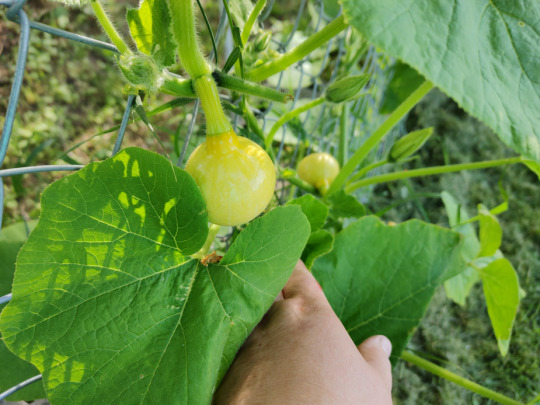
View On WordPress
#2022 garden#Aunt Molly Ground Cherries#bush beans#Cup of Moldova tomato#growing food#kulli corn#Little Gem squash#planning ahead#Red Kuri squash#self sufficiency#vegetable gardening#winter squash#yellow beans
0 notes
Photo

Japanese Red Kuri Squash Seeds, Orange Hokkaido Non-GMO, Organic, Heirloom B10 Cucurbita maxima. (90 days) Also known as "Uchiki Kuri", "Baby Red Hubbard" or "Orange Hokkaido". Japanese Red Kuri is bright red teardrop-shaped squash that averages 5-8 pounds. The flesh is dry and sweet with a delicate nutty flavor. Makes excellent soups, desserts, vegetable tarts, cakes, blinis, pancakes, lasagna, risotto, vegetable stews, and gratins. Very prolific and early. Highly sought after by chefs and in markets. A sell-out every time. Perfect for the home gardener due to its small size, but big flavor.
A red-orange Japanese winter squash, fruit is 5-8 lbs each and teardrop-shaped. The golden flesh is smooth, dry, sweet, and rich; a great yielding and keeping variety. This style of squash has been traditionally farmed in the Kanazawa, Japan area. It is said that Saichiro Matsumoto of Kanazawa brought this squash back from Fukushima in northern Japan, in 1933. It is one of the Kaga (old name of Kanazawa) traditional vegetables.
Flashy and tear-drop shaped. Organic Hubbard Squash
Baby red hubbard with appealing color and shape. Flesh is smooth in texture and great for pies and purées because specks of skin (being red) will not show
Count: 10
Matures in 92 days
Full Sun Sprouts in 5-10 Days Ideal Temperature: 70-95 Degrees F Seed Depth: 1/2-1 inch Plant Spacing: 18-36" Frost Hardy: No Cucurbita maxima
CULTURE: Fertile, well-drained soil with a pH of 6.0–6.8 is best. Plastic mulch and fabric row covers (AG-19 grade) can aid plant establishment and exclude insect pests during the seedling stage. Row covers should be removed when plants begin to flower. Poor fruit development may indicate insufficient pollination. TRANSPLANTING: Sow 2–3 seeds per 2" container or plug flat about 3 weeks prior to transplanting. Thin to 1 plant/container or cell with scissors. Harden plants 4–7 days prior to transplanting. After danger of frost has passed, transplant it out according to the spacing recommendations for each variety. Handle seedlings carefully; minimal root disturbance is best. DIRECT SEEDING: Sow 2 seeds at the appropriate spacing interval for the variety's vine length, 1/2–1" deep. Thin to 1 plant per spacing interval after seedlings are established. PLANT SPACING: Bush to short-vine habits generally requires 6' between-row spacing, while long-vine habits require 12' between-row spacing. In-row spacing depends on fruit size and is generally: small, 18–24"; medium, 24–36"; large, 36–48". DISEASES: Common cucurbit diseases include powdery mildew, downy mildew, bacterial wilt, and phytophthora. Avoid problems with adequate soil drainage, good air flow, insect pest control, and crop rotation. If necessary, check with your local Cooperative Extension Service agent for specific control options. INSECT PESTS: Cucumber beetles, squash bugs, and vine borers are all common pests for cucurbits. Protect young plants with floating row cover. Squash bug eggs found on the undersides of leaves may be crushed by hand. For vine borers, cut out of vines and hill soil over the wound. Keep field borders mowed and remove plant refuse in the fall; spring plow to bury pupae. Pyrethrin sprays may offer some control. HARVEST: Fruits are typically ready about 50–55 days after the fruit set and should be harvested before any hard frosts. Cut fruits from vines and handle carefully. Sun cure by exposing fruits for 5–7 days or cure indoors by keeping squash at 80–85°F/27–29°C with good air ventilation. STORAGE: Store at 50–60°F/10–15°C, 50–70% relative humidity, and good ventilation. Repeated exposure to temperatures below 50°F/10°C may cause chilling damage. Hubbards are better after a few weeks in storage and will keep up to 6 months. Red Kuri is the exception in that it is delicious right out of the field, but will only last a maximum of 3 months. DAYS TO MATURITY: From direct seeding; subtract about 14 days if transplanting.
FREE GIFT when you order 5 items or more. Free gift is full of surprise seeds which may include single or mixed varieties.
Note: No tracking # will be provided to make the shipping cost-effective for us and free for you. Returns & exchanges Not accepted. But please contact me if you have problems with your order http://springsofeden.myshopify.com/products/japanese-red-kuri-squash-seeds-orange-hokkaido-non-gmo-organic-heirloom-b10
#Bateekh Samara#Charentais Melon#Delhi Melon#Hara Madhu#Kajari melon#Kanjari#organic seeds#rare seeds#WHITE LANZHOU
1 note
·
View note
Text
Growing Tip: An Adventure with Squashes Continues!
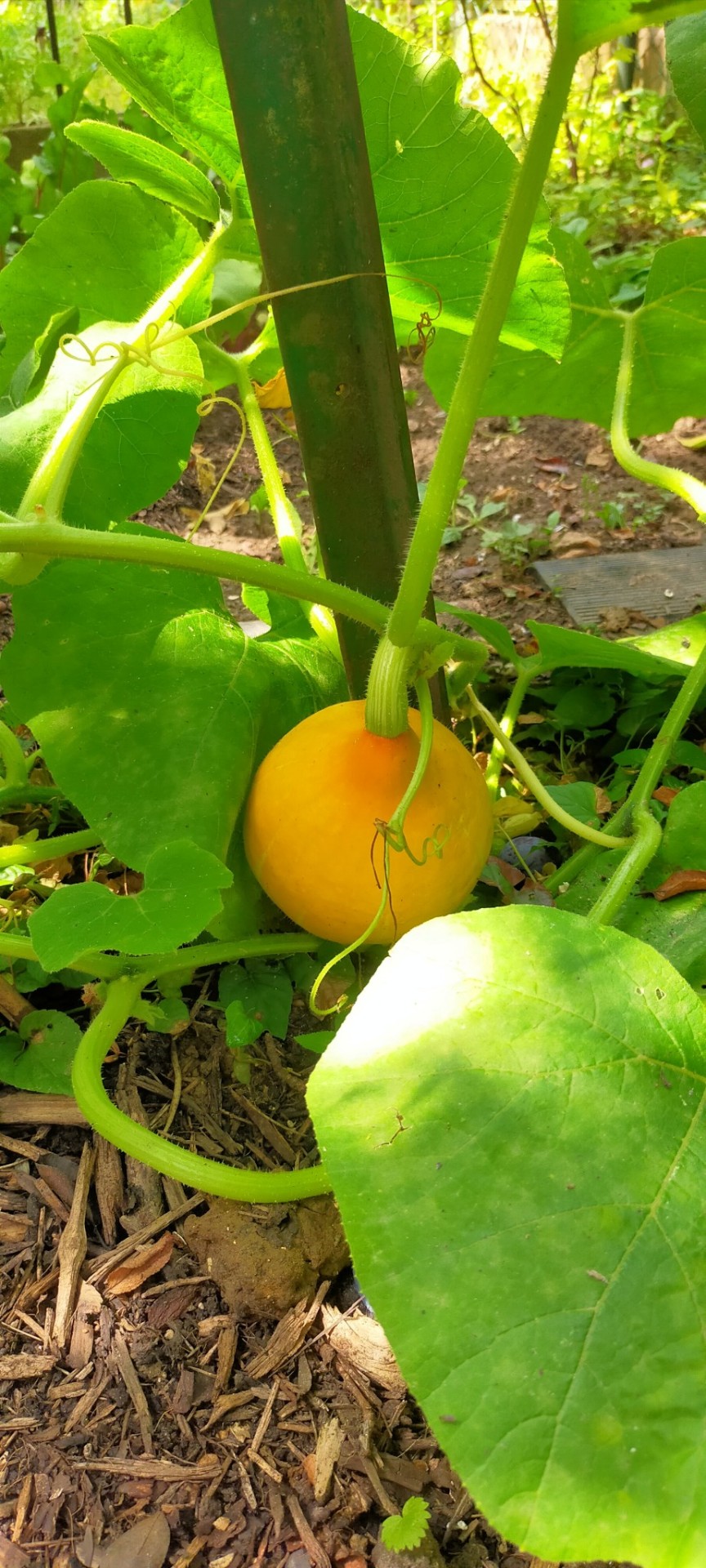
I am really chuffed, I am! I have a gorgeous Red Kuri Squash (top picture) growing in my Bean and Squash Square, or rather quite out of it, and if you have followed my Adventure with Squashes, you can imagine my excitement. It is just (today), starting to take a hint of that characteristic orange hue!
I am not eating it yet, but it has already become my best accomplishment in the Squash department.
When I last wrote about my Squashes, mid-April, I had just planted my seedlings in the Bean and Squash Square, and I was rather optimistic.
I watered them very regularly –at their feet, not on their leaves
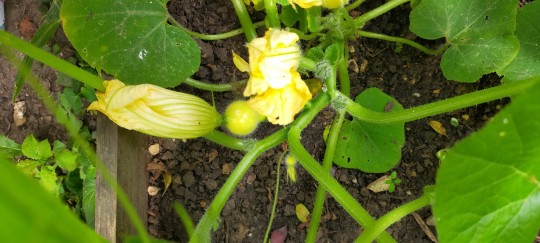
And I was right, for it flowered abundantly (still does!), and I left all the flowers (so far!) to give them a chance to be pollinated. They were, and started growing baby squashes! As the plants grew, I kept watering; and once a month, I would mix 1 cup Onion Skin Decoction and 4 cups Nettle Soup in a watering can, and top with about 8 litres of water, give a good stir and water my plants with this natural fertiliser.
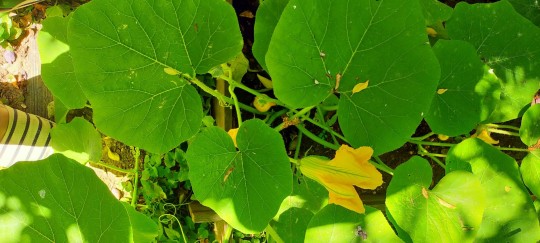
For a while, I let them all the baby squashes grow a bit, until I could see which one was faring better than the others. The first one (second picture), being on the ground and being the earliest, maybe, ended up going soft. So I removed it. I inspected the baby squashes daily, and removed those which went soft or browned. It is a little bit heartbreaking, but it allows the plant to focus its attention on the best ones, and its strength on growing them.
The squash vine became gigantic and quickly outgrew the Squash Square (as my Mum had predicted!) But it found a convenient Plum Tree stake to crawl up on.

And this baby squash became a toddler! I thus removed the other babies on that vine.

And it is quite content with the decision, it seems!

Now, to give it all the best care to grow bigger and bigger, a trim was needed. These beautiful large leaves take up a lot of the plant’s energy, which needs to be focused on growing this squash, and eventually flowering again to grow more squashes.
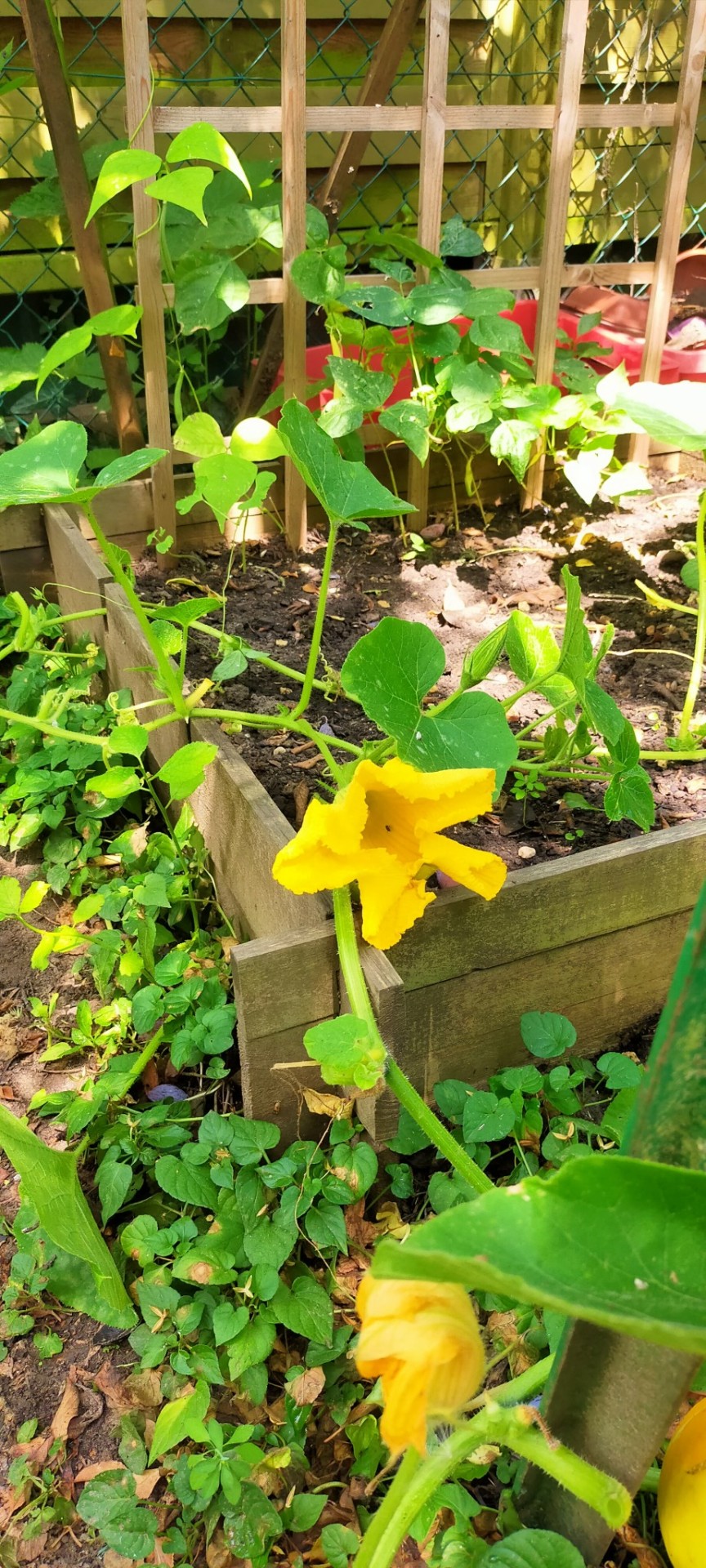
Thus today, I did trim most of the large top leaves, to let the sun shine on the smaller ones and the squash. And did the same to that gigantic vine’s little sister (pictured above, still within the Squash Square!) And the Butternut Squash growing besides them has not yet flowered --I believe she’s a late bloomer, hehe!-- but it shall get more light and room too, and I remain very, very optimistic!
#Growing#Growing Tip#Growing Tips#Growing Squashes#Red Kuri Squash#An Adventure with Squashes#An Adventure with Squashes Continues!#An Adventure with Squashes Update#Squash Square#Bean and Squash Square#Squash#Squashes#Kitchen Garden#Veg Patch#Vegetable Patch#Vegetables#Growing Vegetables#Homegrown#Growing and Gardening#Gardening#Gardening Tip#Gardening Tips#Garden#Back Yard#Home
0 notes
Text
Allotment Update
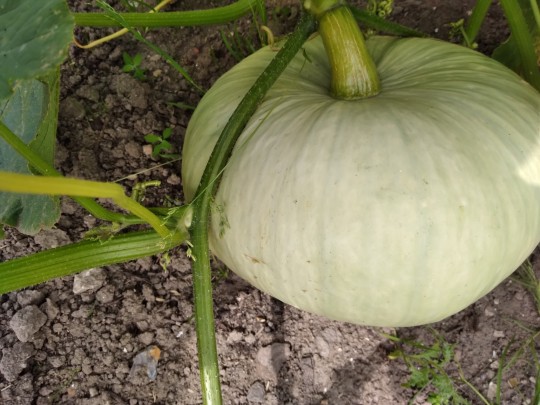
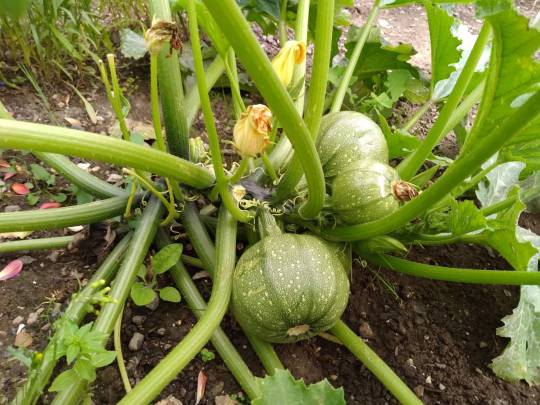
Round courgettes this year (1 plant and still too many) and uchiki kuri squash! We also have patty pan squashes as it is the one thing we are good at growing.
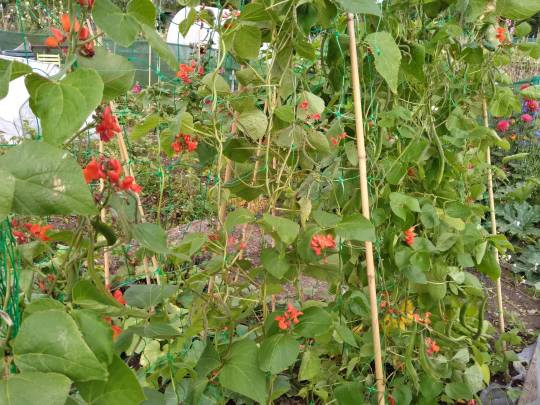

So many beans this year! We made a netting structure which worked really well. There's french beans, runner beans and a type of soup bean
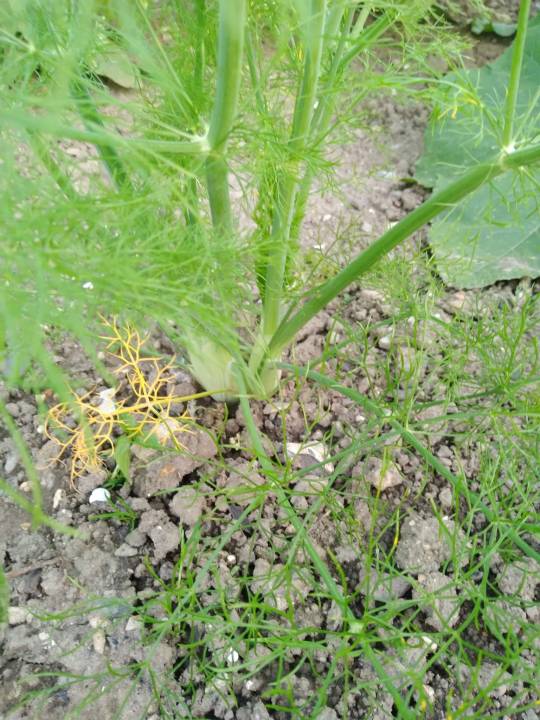

Fennel is so delicious, and not too hard to grow! Plus lots of cucumber species this year.
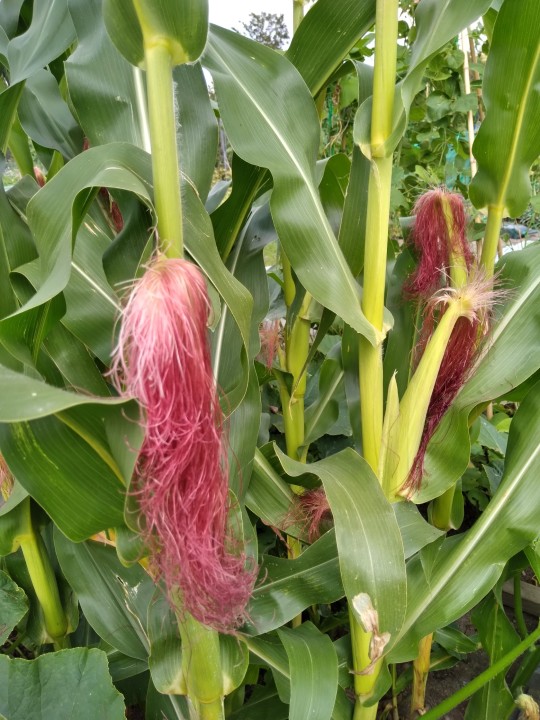
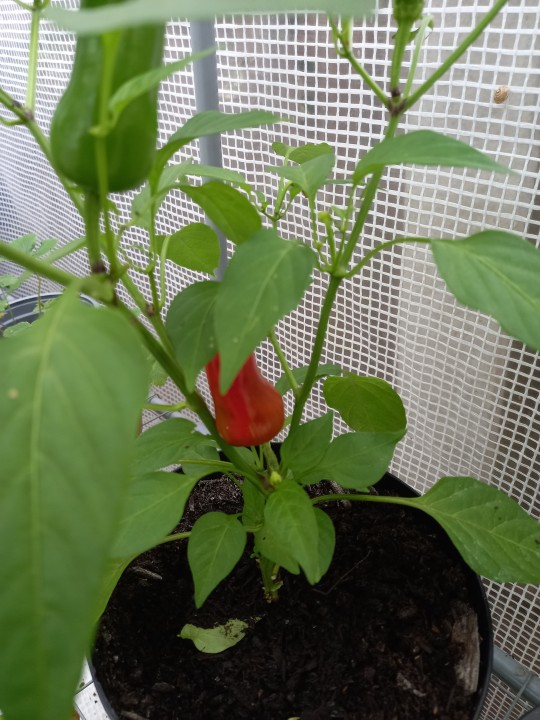
The corn has red tassels... and also some greenhouse jalapeños which miraculously are not dead


Produce, and onions on a DIY drying rack! Have tried some, they are really good.
We did have some potatoes growing but they were hit by blight, so we took them out early. There will be more blue potatoes next time!!
#gardenblr#gardening#plantblr#flowers#nature#outdoor gardening#garden#plants#growing#vegetable plants#vegetables#allotment#courgettes#beetroot
13 notes
·
View notes
Text
Smoothie Ideas
I know I’m posting these for the hell of it, anyway, these being smoothie ideas no one asked for and all, but I think posting an entire fruit smoothie idea would be a little much, even for me. So I’ll separate them into fruit types! I absolutely would do a smoothie of all fruits, by the way, it would just be longer than my cat post. lol f I had access to all of these and a good amount of space to work with as well as room in a freezer, and a good blender/food processor, this is what I would do. All plant parts in equal amounts. Plus plain yogurt and silky tofu for texture. And honey, maple syrup, and cane sugar for added sweetness. Also assume anything toxic or potentially toxic (elderberries and pokeberry, for example) are properly prepared (cooked, seeds removed, etc.).
The only issue is when you get this specific with plant parts, you run into disagreement! Most list just fruits in the squash/melon family as pepos, but I’ve seen bananas and passionfruits included, too. Pepos are berries that have a thick rind and normally many seeds. If bananas count, I don’t see why dragonfruits wouldn’t.
Pepo smoothie
bananas:
banana
finger
plantain
red
bitter melons:
goya
karela
chayote
cucumbers:
English
field
lemon
cucumelon
dragonfruits:
red-flesh pitahaya
white-fleshed pitahaya
yellow pitaya
hairy melon
kantola
melons:
canary
cantaloupe
charentais
Crenshaw
galia
hami
honey
honeydew
kiwano
lemondrop
melonade
Pakistani musk
Santa Claus
sugar kiss
summer kiss
Tuscan
papaya
passionfruits:
granadilla
maracuja
snake melon and parval
squashes:
acorn
ambercup
ayote
buttercup
butternut
calabaza
carnival
chiverre
delicata
honeynut
Hubbard
kabocha
pumpkin
red kuri
sweet dumpling
tiger pumpkin
white swan
tindora
watermelons:
sugar baby
watermelon
wild prickly cucumber juice
winter melon
3 notes
·
View notes
Text
VEGAN PUMPKIN SOUP
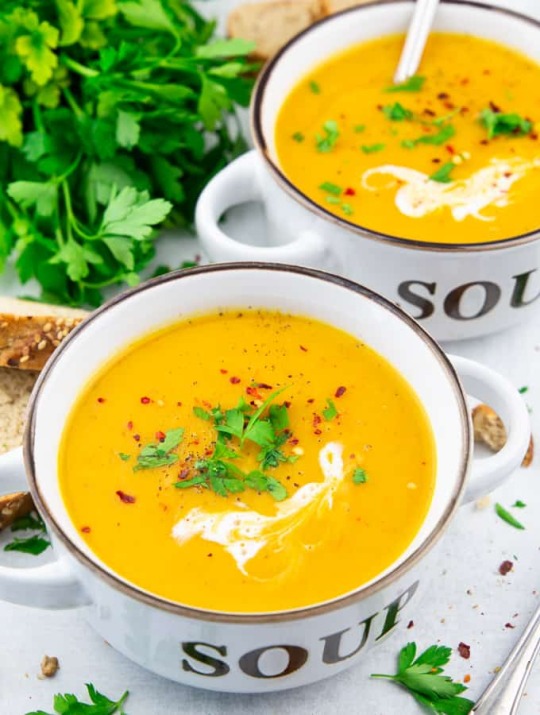
Ingredients
For the vegan pumpkin soup:
25 oz pumpkin (butternut, sugar pumpkin, or red kuri squash)
1 onion, finely chopped
1 clove of garlic, finely chopped or minced
1/2 teaspoon finely chopped ginger
1 can coconut milk
2 medium-sized potatoes, cut into cubes
2 large carrots, cut into cubes
2 1/4 cups vegetable broth
juice of half a lime
1 teaspoon red curry paste (more if your curry paste is not very spicy)
salt, to taste
black pepper, to taste
To serve:
freshly chopped parsley
red pepper flakes
coconut cream
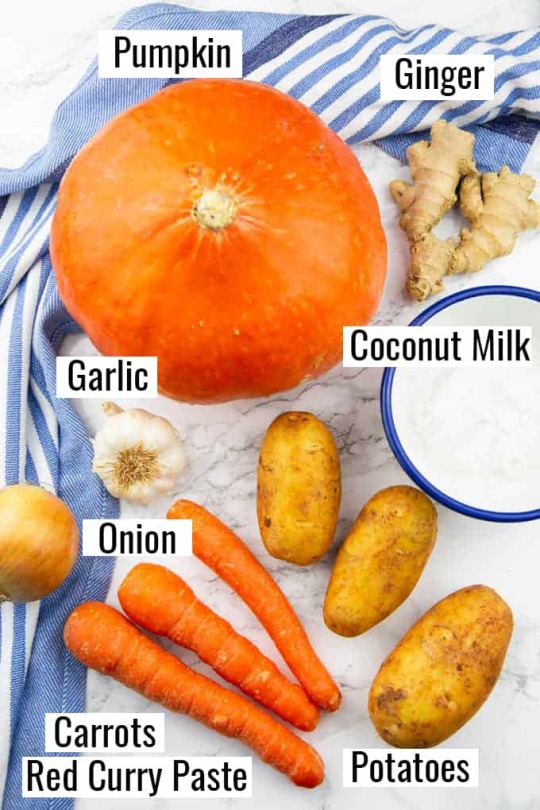
Instructions
Finely chop the onion and the garlic. Peel and cut the pumpkin, the potatoes, and the carrots into medium cubes.
Heat some oil in a large pot and sauté the onion for about 3 minutes or until translucent. Add the the garlic and the ginger and cook for another minute. Then add the pumpkin, the potatoes, and the carrots.
Then add the vegetable broth and the coconut milk. Bring to a boil and then reduce the heat and simmer for about 15 minutes until the vegetables are soft.
Use an immersion blender to puree the pumpkin soup or transfer it to a blender.
Stir in the red curry paste, the lime juice and season with salt and pepper.
Notes
If you want to make your pumpkin soup spicier, you could add some red pepper flakes.
Don’t leave out the fresh lime juice. It gives the soup even more flavor and freshness and it blends in really well.
Make sure the red curry paste you use is vegan if you want the pumpkin soup to be 100 % plant-based. Some brands of curry paste contain shrimp paste.
Nutrition
Calories: 219kcal | Carbohydrates: 23g | Protein: 5g | Fat: 14g | Saturated Fat: 12g | Sodium: 384mg | Potassium: 927mg | Fiber: 3g | Sugar: 6g | Vitamin A: 13770IU | Vitamin C: 22.1mg | Calcium: 69mg | Iron: 5.5mg
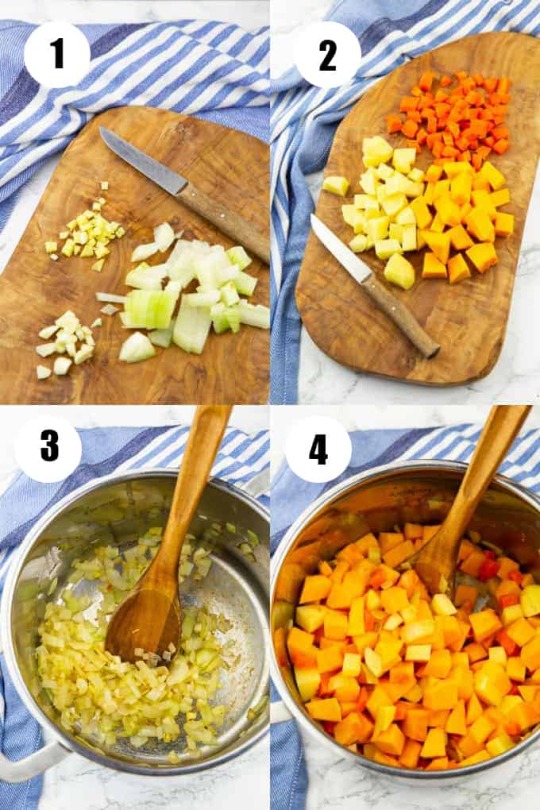
WHAT’S THE EASIEST WAY TO CUT THE PUMPKIN?
Peeling and cutting a pumpkin can be a real pain. But there are some easy tricks!
Slice your pumpkin in half and place it cut side down on a microwave safe dish with a little water. Microwave the pumpkin until it’s easy to remove the skin and cut it into pieces. This will take about 5 minutes. Be careful as the pumpkin will be really hot.
You could also bake your pumpkin in the oven for the same effect.
WHAT ARE THE BEST PUMPKINS FOR SOUP?
For soup are butternut, sugar pumpkin, and red kuri squash.
NOT A FAN OF RED CURRY PASTE?
If you’re not a fan of curry paste, you could also leave it out and add an apple or two together with the vegetables. This adds some really nice flavor to the pumpkin soup. I also love to add some balsamic reduction and chopped walnuts in this case.

https://veganheaven.org/recipe/vegan-pumpkin-soup/
Thank you😊❤️❤️❤️❤️
13 notes
·
View notes
Note
May I ask a headcanon to Kato, Kanten and Montby?
ooo yes I have thoughts about them. Most of these are derived from Kato's weird half-race, and them being triplets has made me wonder why Kanten and Montb looks more human than Kato.
Kato
Sexless and non binary, doesn't mind any pronouns tbh
A part time gardener. He helps around Compote's fruit farm sometimes
Isn't really interested in fighting/swordsmanship, but only learned it because his twin brothers also were learning it, and in the Charlotte household, everyone must be able to fight or you're useless. To be honest though, he'd rather be a gardener.
Everyone was weirded out by him when he was first born. Out of the triplets, he was the one who's inherited the most of the recessive genes of the father, who came from some sort of plant race. There were many leaves involved, and Kato was a fragile little pumpkin. Literally a pumpkin, he had a face but his body was the stem (no humanoid limbs) and the doctors didn't know if it's safe to cut any of the leaves because it might be a part of his body. Kato is also sexless, but to answer Big Mom's question, they just referred him as a son. Researching about Kato's odd half race, they nurtured him like a plant - his bed a rich selected soil and they watered him daily. As he grew up, the leaves connected to his body started to naturally fall off, and his stalk body started to grow out limbs and a humanoid body. By 3 years old, he's able to walk like a human.
When Kato started to walk, they played around a lot, and one time Kanten overpowered him in a wrestle and accidentally tore off a limb of him. That's the time Kato realized he has the natural born power to re-grow out parts of his body by treating it like a plant - bury, water and fertilize. It takes long though.
He's laidback and easy to talk to. People often mistake his pumpkin head as a costume, and tired of being angry about it, he instead goes along with them
Kanten
The healthiest out of the triplets born. He helped look over and nurture his sibling Kato. They grew up close to each other.
The odd shaped of his head is actually a red kuri squash. When he was born, he and Montb looked human so the doctors assumed they were normal. But as they started to grow up, Kanten started to feel the bump on his head. His skin was always a bit reddish hue, and his hair, oddly, is very thin and easy to fall out and regrow like leaves. By 3 years old, a full grown red kuri squash grew with his skin on the top of his head, and if he accidentally bumps it, it hurts him. So he wore a hat (not a helmet - unfashionable and heavy) to protect and hide it.
The other half of his face is also half-red kuri squash, and his eye is like Kato's. He gets bullied for being a weird looking half-plant human, there were times people tried to carve on or cut off the squash part of his skin. He ends being bandaged quite often, and when he grew up, he didn't need the bandages anymore because he could protect himself, but he continues to wear them anyways because it covers the half-plant part of his face, and he thinks it makes him look cool and mysterious
Unlike Kato, he can't regenerate parts of his body. So the scars on his red kuri squash skin and head remains there.
Married off at the early age of 15 and had a son at 16, the bandaged boy (headcanon source)
Montb
he hates his plant-race half, he thinks it makes him physically fragile. This hate extended to hating himself and his triplet brothers for looking the way they are. He's bitter seeing Kato being confident about how he looks, ignorant of his brother's hardships of being able to accept his body.
He separates himself from his triplet brothers (who are also quite close together). He's quite of a loner, and determinedly trains alone to be stronger. Kato and Kanten followed his footsteps in swordsmanship and he hated that they copied him, but the two are unaware
When he was born, he looked completely like a human like Kanten. But as he grew older, he began to realize the change of color and size of his torso - it was turning into a bottle-shaped gourd. It extended to his chin, which is why he clothed himself the most he could: wore a cape, a high collar shirt, long sleeves, gloves, long socks, etc. He feared his body would transform into a complete gourd as he grows older and that he would having to mask his face and be completely an unknown person to the world
(based off this one from Gumi's Coward Montblanc song bc I read that Montb might be derived from the montblanc dessert) Montb has fallen inlove once, but he couldn't express his feelings right. He hated himself and how he looked like, and he couldn't bear the thought of the person he loves being disgusted of how he looks once they see him as he truly is. In the end, he couldn't confess to that person - feelings remained unsaid and before he knew it, it was too late. He hates himself even more and sees himself as a coward.
He has the authority over the Homies guards and overlook patrol duties.
#one piece#op#big mom pirates#charlotte family#text#headcanon#charlotte kato#charlotte kanten#charlotte montb#askbox
18 notes
·
View notes
Text

2018-10-4
Inktober Day 4
Today I drew the Red Kuri Squash, and figured it deserved some color due to its name. I think I made it a bit too red, but my reference picture was very red as well (I just googled “Red Kuri” and found it in images). I’m really happy with is it turned out otherwise, though.
The Red Kuri Squash is also known as the Hokkaido Pumpkin, and it’s scientific name is Cucurbita maxima. It’s a winter squash that’s said to have a mellow, chestnut-like flavor. It’s a vining plant that enjoys full sun, is drought tolerant, and matures in about ninety days. It’s good for a wide variety of cooking, from soups and casseroles to muffins and jams. It’s fairly low in calories at ~80 calories for one cup of it cubed up and cooked, and is a good source of fiber.
That’s a summary of the information I found, I have no personal experience growing this variety. If anyone does, feel free to tell me of your experience! Have you eaten this before? Grown it?
#awaytothelilmoon#me#plants#squash#inktober#inktober day 4#new artist#beginner artist#i did this#proud#colored pencils
2 notes
·
View notes
Text
Asian Red Kuri Squash Creamy Miso Soup
Asian Red Kuri Squash Creamy Miso Soup
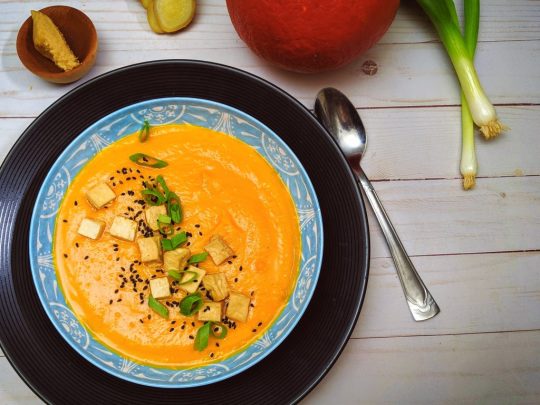
Asian Red Kuri Squash Creamy Miso Soup – Healthy, Plant-Based, Oil-Free, Gluten-Free Vegan Recipe from Plants-Rule Asian Flavor for Creamy Red Kuri Squash Soup
This creamy plant-based soup combines sweet Red Kuri squash with salty miso paste. Subtle spicy heat comes from fresh ginger. It has the perfect balance of Asian flavors. Plus, fun garnishes like sliced scallions and black sesame…
View On WordPress
0 notes
Text
Our 2022 garden: first spinach sown, and onions transplanted
Our 2022 garden: first spinach sown, and onions transplanted
It was a bit cooler and overcast this morning, but still pleasant enough to get the plants outside for a couple of hours.
I am really happy with the newest seedlings. This tray has the cucumbers in the left half, with the Teddy and Red Kuri winter squash on the right. It took so long for the winter squash to germinate, I wasn’t sure they’d make it, but we have 100% gemination!
The purple peas…

View On WordPress
#2022 garden#blooming#budding#corn#cucumbers#Gardening#gourds#growing food#hardening off#high raised bed#onions#peas#planning ahead#seedlings#self sufficiency#spinach#summer squash#tomatoes#transplants#Tropeana Lunga onions#vegetable gardening#winter squash
0 notes
Photo

#Repost @katrinakennedy ・・・ The red kuri squash I found @plantfoundry have been so fun to grow! They trellised beautifully without any extra support and were prolific! I’ve been told they make great pumpkin pie! I’m saving seeds, let me know if you want some! They do need SPACE! The plant grew at least fifteen feet long and up into my fig tree. #gardenthegrid #visitsacramento #growyourownfood #midtowngarden #sacfarm2fork #vegetablegarden #urbangarden #getdirtyeatclean #sacramento365 #backyardgarden #midtowngarden #cagrown #exploremidtown #igersac #visitsacramento #cy365 #captureyour365 #everydayphotography #potd https://www.instagram.com/p/BoCZaLUgfpE/?utm_source=ig_tumblr_share&igshid=7tvcig0geolu
#repost#gardenthegrid#visitsacramento#growyourownfood#midtowngarden#sacfarm2fork#vegetablegarden#urbangarden#getdirtyeatclean#sacramento365#backyardgarden#cagrown#exploremidtown#igersac#cy365#captureyour365#everydayphotography#potd
0 notes
Text
Growing Tip: An Adventure with Squashes

Well friends, if you are regulars here, you may know that Growing Squashes is indeed an on-going adventure in my garden!
My first attempt was in 2020, and I did not have a single squash; but so many flowers, that you can stuff and cook very much in the same way you would Courgette Flowers, that I considered it a success nonetheless!
Last year, I was very organised and optimistic about Planting my Squashes; but it turned out I planted them too early. That is to say, they only had grown their dicot cotyledon (the first two “leaves” on seedlings, which are rather quite different from their actual leaves). I should probably have sown them a bit earlier than April, though. They did grow eventually and expanded, and flowered beautifully (and I refrained from picking flowers to stuff them, and let the bees pollinate them!) And I did indeed Grow Squashes last year, even if they were tiny and made a meal for the birds rather than for me!
But like I said last year, a gardener learns to be patient, learns from experience and learns from their mistakes.
So, this year, I sowed my Red Kuri squash and Butternut squash seeds (still collected from the vegetables I had cooked; before cooking them, naturally) in egg boxes --truly the ideal seed tray!-- on the 27th of February, six seed of each squash, one seed per egg cup. Like last year, I covered them with soil, watered and then I grated coal on top (to prevent seedlings from dying). I kept them inside during germination, on a table under the window in my seed ‘Nursery’, at a temperature of about 18°C/65°F to 21°C/70°F, and watered regularly (whenever the soil was dry to the touch; about every couple of days).
On the 11th March, a Red Kuri Squash seedling and a Butternut Squash seedling started sprouting. Three days, later, another Red Kuri Squash seedling sprouted. I was very attentive to them, kept watering them when needed until they reached about 10cm/4”.
At this stage (on the 26th March) though, instead of planting them outside like I did in 2021, I transfered each seedling to its own larger pot (in potting soil) and kept them in The Nursery. I continued tending to them, until they grew proper leaves. On the 4th of April, they had each grown two real leaves!

And today, on a sunny and warm day (18°C/65°F), I planted them in the same square where I also planted Wax Beans , as Squashes and Beans are, I’ve read, great companions. I tried to space them by at least 55 centimetres/21.65 inches. I watered them, too.

The fact that each Squash seedling have at least three real leaves, and will be growing on a raised bed alongside their Bean mates make me very optimistic!
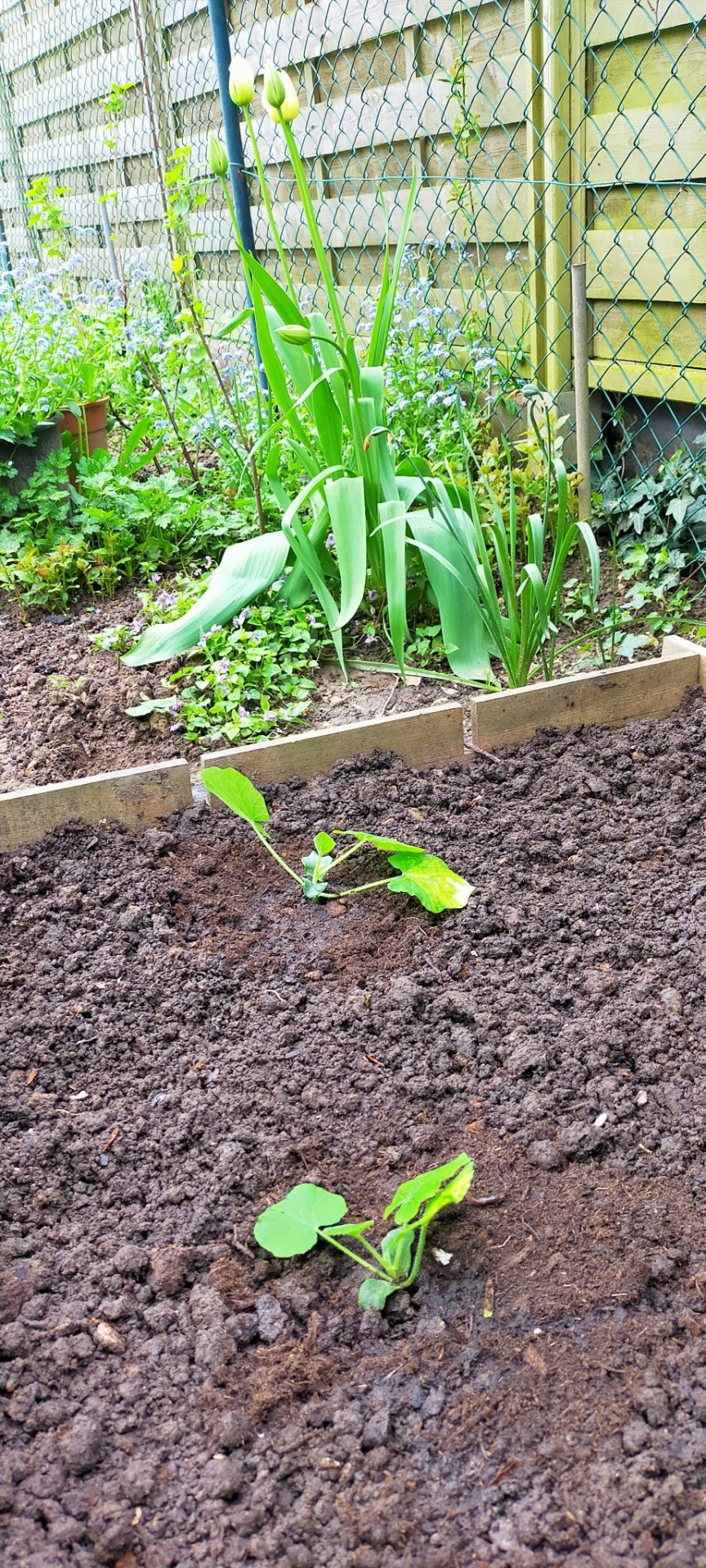
The adventure continues; stay tuned until the next episode!!
#Growing Squashes#Butternut Squash#Red Kuri Quash#Butternut Squash Seedling#Butternut Seedling#Red Kuri Squash Seedling#Red Kuri Seedling#An Adventure with Squashes#Growing#Growing Tip#Growing Tips#Growing and Gardening#Kitchen Garden#Vegetable Patch#Veg Patch#Companion Planting#Garden#Gardening#Home
5 notes
·
View notes
Text
Pasta + Pumpkin Sauce in 3 Ways (Vegan, Gluten-Free) plus how to use up any gourd you find!
Happy Fall + October!
Have you made Happy Herbivore Pumpkin Bread yet???? Get on that ;)
I always have random amounts of leftover pumpkin puree this time of year from baking all the pumpkin things and making vegan PSL at home (WHY is Starbucks still not offering a vegan one???)
SO I've been using my leftover pumpkin and squash puree--more on that in a second---to make healthy sauces for pasta (or spaghetti squash, or grains, or whatever).
I've included two of my favorite pumpkin sauce recipes below plus the third one will be on the Reducetarian's blog on Monday (October 14).
If you're not feeling saucy, here are 11 other vegan uses for leftover canned pumpkin.
HOW TO SAVE BLAND SQUASHES:
This time of year I'll buy any gourd that looks pretty (and isn't labeled as "ornamental", though I suppose one day I'll eventually become curious enough and try to eat one of those...)
MOST OF THE TIME the new squash is delicious "naked" when baked but sometimes they come out horribly bland. When that happens, I mash the squash into a puree and use it as I would the leftover canned pumpkin in these recipes. If you pressure cook or microwave your squash and the texture is off-putting (rubbery) or it's too wet/watery (or bland) mashing into a puree is a great "recycle" option over the trash bin.
DUMPSTER SQUASH COOKIES:
I also sometimes make "dumpster" oat cookies with the squash: Add a mashed ripe banana (or peanut butter) and oats until it holds together. Make cookie shapes and bake at 350F until firm.
3 VEGAN (GLUTEN-FREE, OIL-FREE, PLANT-BASED) PUMPKIN SAUCES
Here are two of my favorite pumpkin sauce recipes. The third one will be on the Reducetarian's blog. You could also make these with mashed up carrots, sweet potato, or butternut squash. They'll be sweeter-tasting that way which could be good if you have kiddos.
I recently made the Thai Red Curry Sauce with a red kuri squash and it was so rich and velvety!!! DROOOOOL. It was hilarious trying to say the name "Red Kuri Red Curry" to our dinner guests.
*I find these sauces are enough for 4-oz pasta (that's a dry measurement) but how "saucy" you like your pasta might be different :)
Table of Sauces Shared here:
Pumpkin Cheese Sauce
(from Happy Herbivore Gets Saucy)
Creamy Pumpkin Sage Pasta Sauce
Thai Red Curry Pumpkin Sauce
Pumpkin "Cheese" Sauce
1/2 cup soy or almond milk
1/4 to 1/3 cup pumpkin (or squash puree)
2 1/2 tbsp nutritional yeast
1 tbsp tomato paste (or 2 tbsp ketchup)
1 1/2 tsp cornstarch (optional)
1/2 tsp garlic powder
1/2 tsp onion powder
In a saucepan, whisk together all ingredients. Heat over low, stirring, until warm and thickened. Add salt and pepper to taste if desired.
*Use cornstarch for a thicker and spreadable cheese sauce. If you decide after the fact you want to thicken the sauce, whisk cornstarch into 1 tbsp warm water and then mix into sauce.
This is from Happy Herbivore Gets Saucy: 191 oil-free vegan sauce recipes and vegan oil-free salad dressings. There's a picture and meal idea for every recipe... get Saucy with me ;)
Creamy Pumpkin Sage Pasta Sauce
4-oz pasta or noodles
3/4 cup coconut milk (or almond milk, or vegetable broth)
3/4 cup pumpkin (or squash puree)
1-2 tbsp minced fresh sage (about 6-7 leaves)
pinch dried oregano
1-2 tbsp tomato paste (or 1/4 cup ketchup)
cashews or pumpkin seeds (optional)
pumpkin pie spice or cinnamon (optional)
Prepare noodles or pasta as directed. For the rest of the directions, visit Reducetarian's blog! (The recipe will be posted October 14, 2019).
In a saucepan, whisk together all ingredients. Heat over low until warm, about 5 minutes. Add salt and pepper to taste. Rest sauce for 10 minutes then stir together with cooked pasta. Garnish with breadcrumbs, chopped sage, and a sprinkling of nutritional yeast, if desired.
For a richer sauce, blend in soaked cashews or shelled pumpkin seeds (2-4 tbsp). You can also add a few dashes of cinnamon or pumpkin pie spice (1/8 tsp or less) to evoke a hint of "pumpkin pie" flavoring.
Thai Red Curry Pumpkin Sauce
1 cup pumpkin (or squash puree)
1-2 tbsp Thai red curry paste
1/4 lime (juice and zest)
coconut aminos (or soy sauce)
vegetable broth (or coconut milk)
In a blender, combine pumpkin with 1 tbsp red curry paste, lime juice, and a pinch of lime zest. Puree into a creamy sauce, adding broth or coconut milk as needed for consistency (think: Alfredo sauce). Stir in a light drizzle of coconut aminos or soy sauce (if desired) plus more curry paste or lime to taste. Heat until warm on the stove then stir in cooked pasta until lightly coated.
from Recipes Blog https://happyherbivore.com/2019/10/vegan-pumpkin-curry-pumpkin-mac-pasta-sauce-gf/
0 notes
Text
Smoothie Ideas
radblr: found a new topic to go at one another’s throats over
me: Anyway, another smoothie idea no one asked for. If I had access to all of these and a good amount space to work with as well as room in a freezer, and a good blender/food processor, this is what I would do. All plant parts in equal amounts. Plus plain yogurt and silky tofu for texture. And maple syrup, honey, and cane sugar for added sweetness.
Orange smoothie
honey: fall
ambarella
apples:
jazz
crabapples
Cripps pink
honeycrisp
royal gala
apricot
Barhi date
carrot
chanterelle mushroom
cherry tomato
chestnut
citrus:
bergamot
cara cara
clementine
grapefruit peel
kumquat
Mandarin
Minneola
navel
ponkan
satsuma
Seville
Sunkist
tangerine
tangor
Ugli fruit
cloudberry
gandaria
genip
husk cherries:
Chinese lantern berry
clammy groundcherry
goldenberry
loquat
lucuma
mamey zapote
maracuja passionfruit
mangoes:
Ataulfo
Hayden
palmer
melons:
cantaloupe
Charentais
Crenshaw
Hami
honey kiss
orange flesh honeydew
Tuscan
nance fruit
nectarcot
orange cauliflower
orange jelly mushroom
papaya
peach palm fruit
peaches:
donut
nectarine
pears:
Flemish beauty
Forelle
peppers:
habanero
orange bell pepper
persimmons:
American persimmon
date-plum
Fuyu
Hachiya
sharonfruit
plums
purple mombin
Rainier cherry
rose hips and petals
rowan berry
rutabaga
sea buckthorn berry
squashes:
acorn
ayote
buttercup
butternut
calabaza
delicata
Hubbard
pumpkin
red kuri
sweet dumpling
sweet potato
5 notes
·
View notes
Text
Boost Profits and Prolong Growing Season with Japanese Vegetables
Whether you are looking to boost profits at a farmers market or extend your growing season, Japanese vegetables are the way to go. Japanese vegetables should be grown on the homestead because of their heavy yields, aesthetics, adaptability, and palatability. In the Japanese countryside regardless if the household is a humble farmhouse or a 21st century marvel, it is rare to see a home without a vegetable plot. Regardless of your climatic situation, make space this year for Japanese crops — they’re delicious and resilient.
Japanese Vegetable Garden
Japanese vegetable gardens are positioned near the home and in the sunniest of locations. Many times, multiple generations are living in one house. The garden’s accessibility to all family members is important and should be incorporated into the garden design.
“People with little space put that space to use. Gardening, in general, is very big in Japan,” Jere Gettle, founder of Baker Creek Heirloom Seeds says.
Japan has many rivers, and gardens are often planted near them, or near irrigation canals to maximize growth. If you lack space, grow your Japanese vegetables vertically, with cucumbers, melons, squash, tomatoes, beans, and peas traditionally supported on long bamboo stakes cut from the hedgerow. Trellising allows for better air movement and access to more sun. Companion planting with vegetables and flowers and rotation of crops is often utilized in Japanese gardens.
Japanese long cucumbers grow great on trellises. Photo courtesy of Baker Creek Heirloom Seeds.
Yard long beans are good raw or cooked and produce high yields.
“What makes Japanese varieties so special is that the Japanese people stick with the project from generation to generation. Vegetables have been selected for hundreds of years for varieties which produce the most crops, most beautiful flowers, and best-tasting vegetables,” said Gettle. “Once farmers grow and taste Japanese vegetables, they often do not grow other varieties.”
Ready to Start Your Own Backyard Flock?
Get tips and tricks for starting your new flock from our chicken experts. Download your FREE guide today! YES! I want this Free Guide »
In Japan, varieties are selected for first their flavor, then uniformity, and then shipping. American crops are selected first for uniformity, shipping, and then flavor. By growing Japanese vegetables you’ll be tasting some of the most flavorful crops. Selling at farmers markets reduces transportation and allows you to sell your fresh food fast.
Vegetable gardens in Japan are in use year-round. Some of the best winter vegetables include onions, garlic, carrots, and daikon radishes which are often let to sit under the snow to sweeten. Japanese bunching onions resemble strong-flavored scallions. They can be harvested for their green shoots or white stems. ‘Red Beard’ is a beautiful variety with its red stalk and looks great at a farmers market. It is easy to grow, with the red stalk reaching a foot long and the entire plant growing up to 27 inches.
Minowase daikon radish grows huge and is sweet and crisp. Photo courtesy of Baker Creek Heirloom Seeds.
Radishes are very important in Asian gastronomy. They can be pickled, turned into a pudding, eaten raw or cooked in soups, stir-fries, and casseroles. Daikon radishes, like other radishes, are quick to grow, don’t need great soil and can be planted within existing crops. Unlike Western radishes which are small, round and red, Asian radishes can be red, pink, green, or white and oblong or tapered and range from mild to spicy. It’s easy to see customers being attracted to the variety of radishes at a farmers market. Offering free samples can help attract customers that might be aloof to the new varieties.
Early spring vegetables include many leafy greens, which are staples in soups and stir-fries. Mizuna is a mild Japanese mustard that is popular as a salad green and tastes great cooked. Mizuna has long, slender stems with serrated leaves. Colors range from lime green to red streak to purple.
Red streaks and lime streaks mizuna. Photo courtesy of Baker Creek Heirloom Seeds.
Benihoushi mizuna. Photo courtesy of Baker Creek Heirloom Seeds.
Japanese pickling eggplant. Photo courtesy of Baker Creek Heirloom Seeds.
Growing vegetables in pots, as well as herbs, is convenient for those with limited space. Shiso (Perilla frutescens) is a member of the mint family with its seeds, leaves, and sprouts being used in Japanese cuisine. Its flavor is a mix of mint, anise, basil, and cinnamon along with grassy notes. Shiso has a unique flavor profile. It’s versatile and can be used to garnish drinks or flavor entrees, desserts, or fruit bowls. Chrysanthemum greens are often sold as mature leaves which should be blanched for 30 seconds, and then cooled and served with salad dressing. Growing chrysanthemum greens at home allows you to harvest young tender greens for a fresh salad or soup topping. The Japanese also dip chrysanthemum flowers into sake at the beginning of meals to symbolize good health.
Shiso Kaori Ura. Photo courtesy of Baker Creek Heirloom Seeds.
Try These Japanese Varieties on Your Homestead
Bunching Onions
Evergreen White Nebuka
Heshiko
Tokyo Long White
Red Beard
Chrysanthemum Greens
Garland Round Leaved
Garland Serrated Leaf
Komi Sungiku Salada
Oasis
Cucumbers
Japanese Long Cucumber
Suhyo Cross
Summer Dance
Tasty Green
Tasty Queen
Zipangu
Eggplants
Black Shine
Choryoku
Kyoto Egg
Millionaire
Mizuno Takumi
Japanese Pickling Eggplant
Japanese White Egg Eggplant
Herbs
Mitsuba, Japanese Parsley
Red or Green Shiso
Japanese Mugwort var. Yomogi
Green peppers
Fushimi
Himo Togarashi
Managanji
Shishito
Tenderbell
Leafy Vegetables
Alrite spinach
Giant Red Mustard Greens
Japanese chard var. umaina
Misome var. choho
Misome var. misome
Mizuna
Wakamine cabbage
Melons
Japanese Cream Fleshed Suika Watermelon
Ichiba Kouji
New Melon
Radishes
Japanese Minowase Daikon Radish
Shogoin Globe
Sakurajima Mammoth
Giant Luo Buo
Tomatoes
House Momtaro
Japanese Black Trifele Tomato
Momotaro Tough Boy 93
Odoriko
Winter Squash
Akehime
Blue Kuri
Chirimen
Kogiku
Sweet Mama
Shishigatani
Do you grow Japenese vegetables? If so, what are your favorites?
Boost Profits and Prolong Growing Season with Japanese Vegetables was originally posted by All About Chickens
0 notes